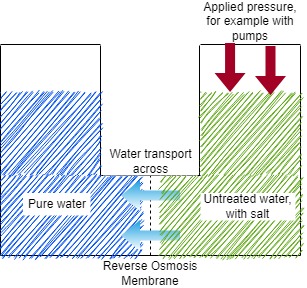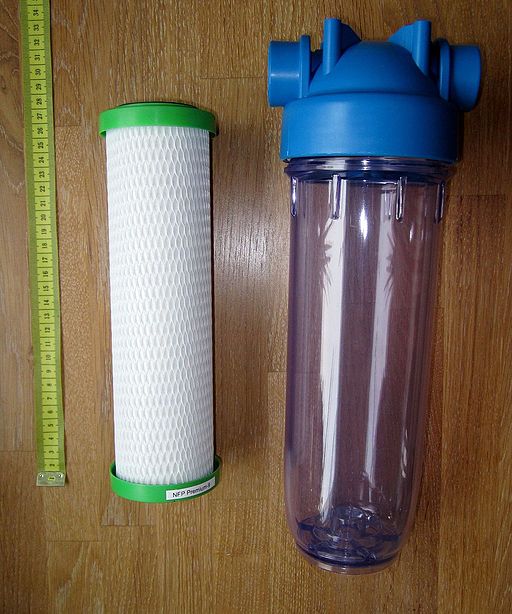In many parts of the world, tap water quality is sufficient for washing and bathing, but not necessarily safe for drinking. To give an example, this map shows the countries of the world where tap water is safe to drink, and where it generally is not. You can see there are many countries where drinking tap water isn’t always safe. The reasons for this vary, but are usually due to the risk of waterborne illnesses. Residents who have been in contact with a higher microbial load for longer are at lower risk of falling ill due to waterborne diseases than travellers.
Most places where drinking water is not available depend on one of two things: bottled water or filtered water. Bottled water is the most obvious solution – sadly it creates a lot of waste and emissions. Domestic water filtration is the practice of small-scale water filters that are placed on the incoming water line to a house or business. Usually, these filters consist of one of two options: Reverse Osmosis (RO) or Carbon Filters.
Reverse Osmosis
This filter technique, RO, is used on a large industrial scale as well as on small scale domestic water filters. RO works by using pressure to force water molecules through a membrane that is semi-permeable, meaning it does not allow dissolved salts and solids to pass through it, but only water. This gives two streams: a clean stream of (nearly) pure water that has been through the membrane, and a ‘reject’ stream that contains all the salt and solids that were in the incoming (raw) stream.

This graphic shows a simple representation of an reverse osmosis system. On the right, the incoming tap water is shown in green, pressurised using pumps from the water company. The pressure pushes the water through the membrane and leaves behind the salt. The leftover water with salt is then thrown away.
Domestic RO normally uses the pressure of the incoming tap water to perform the separation. The problem with this is that the low pressure from the tap water network only allows a small part of the water to go through the membrane. Only about 20%-25% of the incoming water becomes purified. The other 75%-80% is wasted. The normal sales story is that this ‘wasted’ water isn’t really wasted because it is ‘used to clean your drinking water’. This is of course not true: 100% of tap water gets extracted from limited sources such as underground wells, gets treated using machinery and chemicals, and pumped using electric pumps. Domestic RO plants then throw at least three quarters of this down the drain, even though better methods exist that don’t waste any water.
Domestic RO filters, just like larger scale RO filters, need replacement after some time. Most of the time, these filters will work for up to 5 years, but they can waste up to 10 times as much water after this time. This makes it expensive to run if the filter is not replaced, as well as risking contamination from bacterial growth after some time. Another disadvantage of this method is that it needs more space to be installed, and a separate pipe system from the mains water line.
The benefits of using RO for domestic water is that it removes dissolved salts as well as bacteria and viruses. For full details on Reverse Osmosis, check out this detailed scientific article about RO.
Activated Carbon
Also called AC, activated carbon is a method which we have covered in detail in a separate scientific article. The basic treatment principle is very different from RO: activated carbon is a type of carbon, derived from charcoal or coal, that has a very high surface area. This surface area captures pollutants like chemicals from the water, making it safe to drink. AC is easy to install and requires not much space.

The image here shows a small scale carbon filter for a domestic water filters system. The cartridge (left) is a cylinder made of activated carbon. The water is pushed through the filter from outside to inside, and collected in the central tube.
The main benefit of this method is that it requires almost no extra pressure, and no water is wasted which makes it cheaper than RO. The disadvantage is that this method does not remove salts. This means that in areas where water is not drinkable due to a high concentration of salts, this filter method does not work. Additionally, just like for a domestic water filter using RO, the filter needs replacement after some time.
Prefilters
Some domestic systems use one or more prefilters for water filtration, to remove solids from the incoming water. This is mostly done to remove sand and other small pollutants that could damage or plug the final filters.
Off-Grid Water Filters
Combinations of the two methods mentioned above exist to treat drinking water in areas where no connection to a tap water system exists. Here, water from wells or rivers is used to generate drinking water for one or multiple people. These off-grid water filters are usually a combination of coarse and fine prefilters and activated carbon, RO (if enough electricity is available), and UV treatment. Chlorination is optional but sometimes used if the produced drinking water is expected to be stored for more than a day.
Final Thoughts
Domestic water filters can be incredibly useful and important in the right situation. Many countries have water systems that are not safe to drink for visitors, whereas in some areas tap water is completely undrinkable. In these countries, small scale domestic water filters can be a solution to create safe drinking water.
Most people in Western countries live in areas where tap water is perfectly safe and drinkable. This makes un unnecessary to have a water filter at home, although many people still have them to remove chlorine taste from their water, or to reduce the amount of chemicals that is in their water. In most places this is not a necessity for safe drinking water, although there is of course always room for better water quality at home.